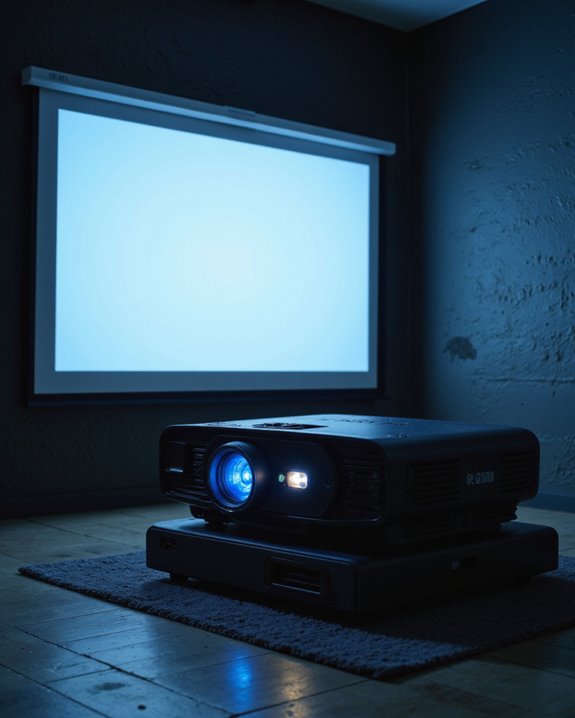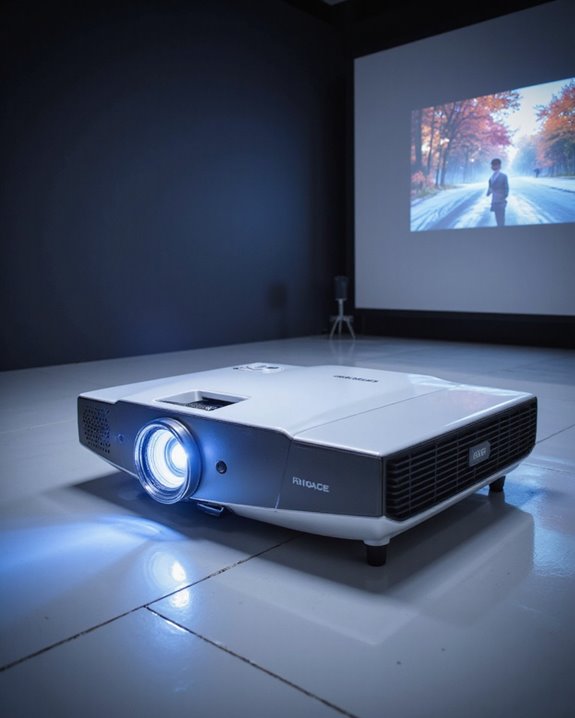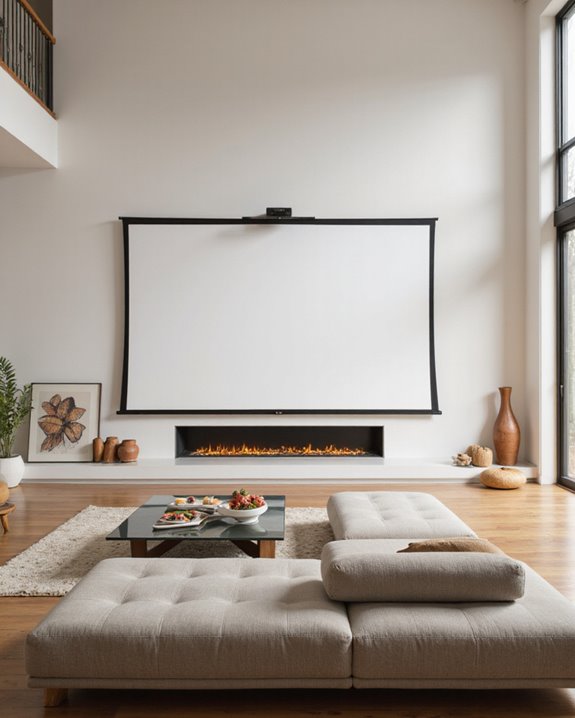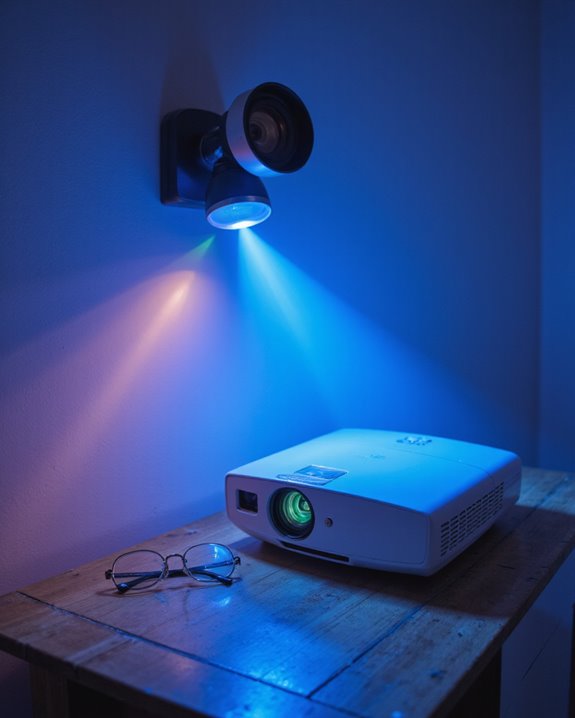Projector screen paint effectively transforms walls into high-quality viewing surfaces for home theaters. The specialized paint contains microscopic reflective particles that deliver professional-grade projection performance, supporting up to 4K Ultra HD resolution. It costs considerably less than traditional screens, ranging from $22-$269 per gallon, while offering comparable image quality when properly applied. Proper surface preparation and application techniques are essential for ideal results. Understanding the differences between white and gray options can help viewers achieve their perfect home theater experience.
Key Takeaways
- Projector paint effectively works as a screen alternative, offering up to 4K Ultra HD resolution when properly applied to smooth surfaces.
- The technology uses microscopic reflective particles to create professional-grade projection surfaces with gain values up to 1.24.
- Cost-effective solution ranging from $22-$269 per gallon, significantly cheaper than traditional screens that start around $300.
- Proper surface preparation and application are crucial, requiring meticulous sanding and multiple thin coats for optimal performance.
- Long-term durability and low maintenance make it a viable option, with added benefits of thermal insulation and soundproofing.
Understanding Projector Screen Paint Technology
While traditional projection screens have served home theater enthusiasts well, projector screen paint represents a revolutionary advancement in viewing technology. This specialized coating contains microscopic reflective particles that transform ordinary walls into high-performance projection surfaces, offering exceptional color accuracy and surface durability.
The technology works through a sophisticated system of “leafed and channeled mirrors” at the microscopic level. These particles direct projected light back to viewers while rejecting ambient light, resulting in sharper images and better contrast. The paint’s structure enables a flat spectral response, ensuring colors remain true to source without shifting or tinting. High-quality formulations like Paint on Screen S1 Ultimate Contrast achieve a remarkable contrast ratio of 2250:1.
Modern formulations can support up to 4K Ultra HD resolution when properly applied to smooth, rigid surfaces. The paint creates a permanent, uniform viewing surface that can be maintained through simple cleaning procedures, making it a versatile projection surface for various environments.
Key Performance Benefits and Features
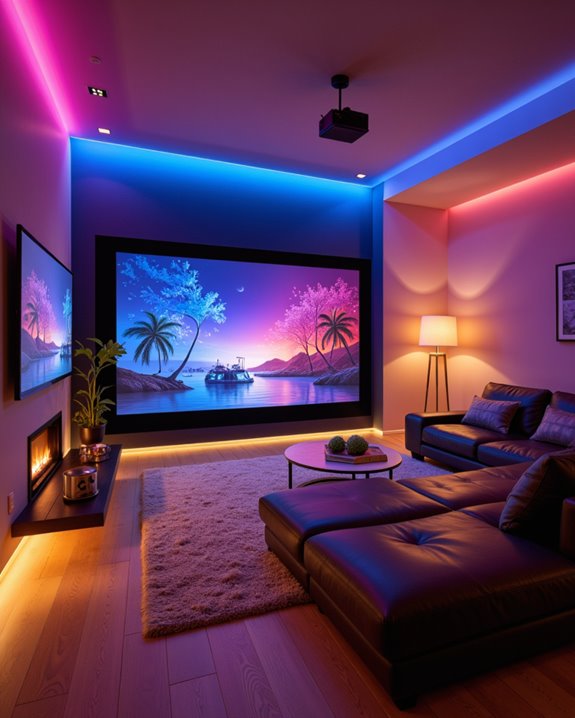
The remarkable performance benefits of projector screen paint extend far beyond traditional screen capabilities. Modern formulations offer enhanced brightness through varying gain values, with some paints delivering up to 1.24 gain for superior image clarity. Surface textures remain smooth and uniform, preventing distracting roller marks and hot spots that can compromise viewing quality. Paint on S1 Ultra maintains excellent color accuracy with minimal grayscale errors compared to reference standards. Color calibration capabilities are impressive, with high-performance paints providing balanced color reproduction across the brightness spectrum. The technology also incorporates ambient light rejection features, making it suitable for rooms with moderate lighting conditions. When properly applied, these paints can transform any smooth wall into a professional-grade projection surface while offering additional benefits like thermal insulation and soundproofing. This versatility, combined with durability and low maintenance requirements, makes projector paint an effective solution for home theater enthusiasts.
Cost Analysis: Paint Vs Traditional Screens
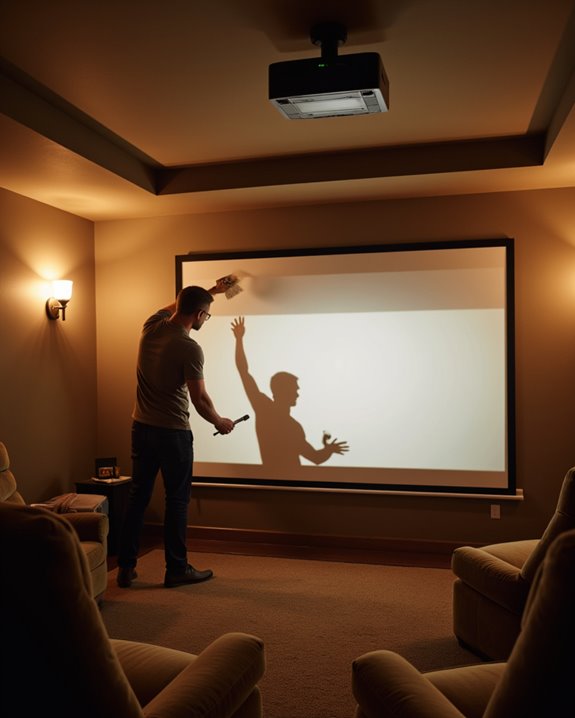
Making an informed decision between projector paint and traditional screens requires careful consideration of upfront costs, installation expenses, and long-term maintenance requirements. A cost comparison reveals that specialized projector paint, ranging from $22 to $269 per gallon, often proves more economical than traditional screens, which start at $300 and increase with size and features. Standard pure white paint offers a cost-effective alternative that maintains excellent color accuracy for projection. Additionally, the durability of the surface impacts the longevity and ongoing expenses, with projector paint providing a permanent solution that minimizes ongoing costs. Material durability factors profoundly into long-term expenses. While projector paint offers a permanent solution with minimal maintenance needs, traditional screens may require periodic replacement due to wear or mechanical issues. Installation costs vary, with paint requiring thorough wall preparation and possible professional application, while screens need mounting hardware and sometimes expert installation. For large viewing areas, paint becomes particularly cost-effective, as traditional screens become exponentially more expensive with increased size.
Application Requirements and Best Practices
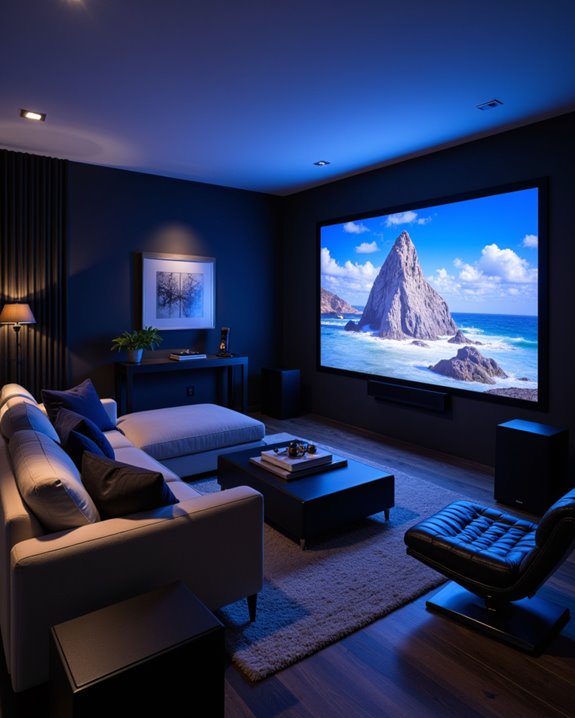
Successful application of projector screen paint demands meticulous attention to surface preparation and proper painting techniques. The wall must achieve a smoothness level of 3-4 on the EU standard, with proper sanding using 120-220 grit sandpaper. Color matching and surface durability depend on following a strict preparation process. Advanced options like Diamond Infused coatings provide superior projection surfaces for premium home theater installations.
Key requirements include:
- Using a high-density foam roller for streak-free application
- Applying two coats with 24-hour drying intervals
- Ensuring proper surface preparation with smart white primer
- Maintaining room conditions suitable for paint application
The paint’s water-based formula allows for easy cleanup while providing professional results. Final surface quality directly impacts image clarity and projection performance, making proper application essential for achieving ideal screen characteristics and long-term durability.
White Vs Gray Paint Options Compared
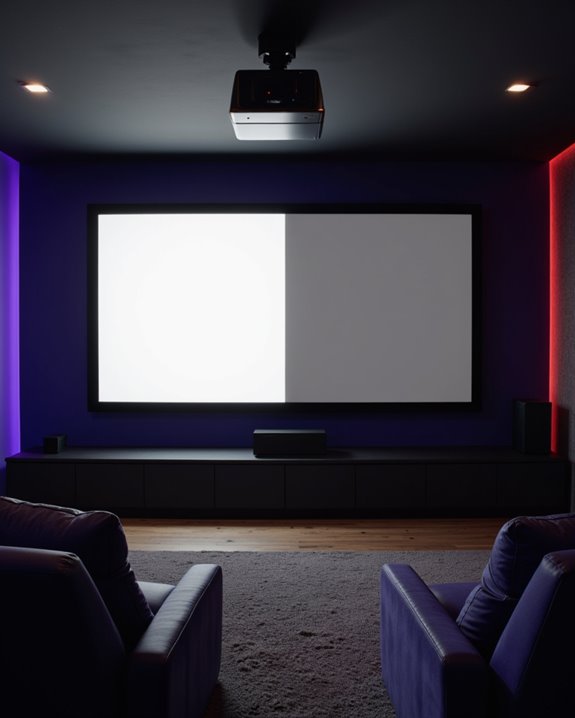
While both white and gray projector screen paints offer distinct advantages, understanding their key differences helps users select the most suitable choice for their viewing environment. White paint typically maintains better color accuracy and delivers brighter images with a gain value of around 1.1, making it ideal for rooms with good light control. The surface texture remains vital for both options, requiring proper preparation and application techniques. Specialized products like Smart Pro Paint have revolutionized home theater setups with enhanced performance capabilities.
Gray paint excels in rooms with ambient light, providing enhanced contrast and deeper black levels. However, it may require color calibration to correct potential white balance issues, especially at peak brightness. The matte finish of either option helps prevent hot spotting, though gray paint’s darker surface can reduce overall light output compared to white alternatives.
Real-World Performance in Different Lighting
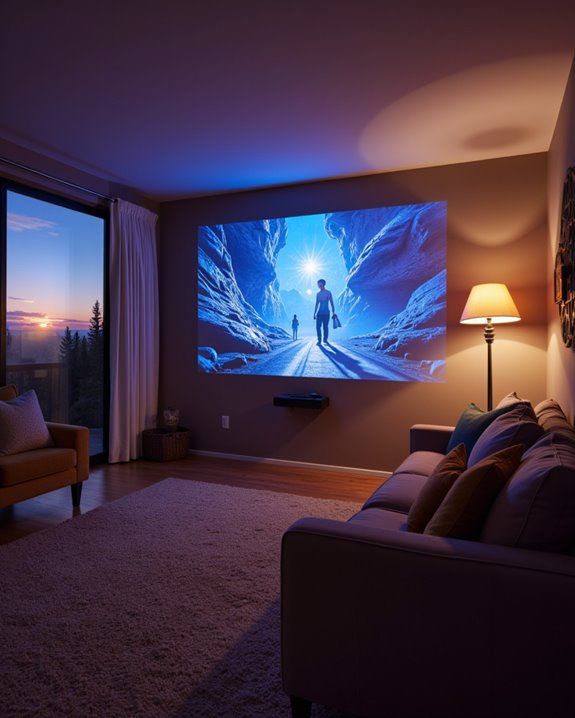
Real-world testing reveals dramatic differences in how projector paint performs across various lighting conditions. In dark rooms, high-gain white and silver formulations deliver excellent color accuracy and contrast, rivaling dedicated theater screens. However, ambient lighting significantly impacts performance, with some paints reflecting less than 15% of projected light in bright conditions.
White projector paint maximizes brightness but suffers from washout when ambient light is present. Grey paint better handles moderate lighting by absorbing unwanted light, though this comes at the cost of overall brightness. Paint On Screen’s silver finish provides 1.5 gain coverage, offering enhanced brightness while maintaining image quality. Specialized ambient light-rejecting (ALR) paint formulations offer a middle ground, maintaining decent image quality in partially lit rooms. For vital results, controlling room lighting remains essential, as even the best projector paints cannot match dedicated ALR screens under severe ambient light conditions.
Common Challenges and Solutions
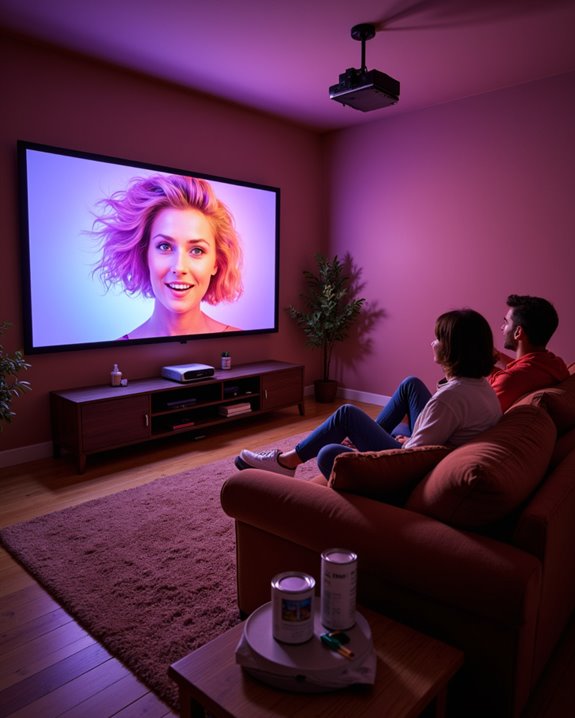
Creating a high-quality projector screen with paint requires addressing several key technical hurdles. The most critical challenges include surface preparation, paint application technique, and maintaining consistent performance over time. Uneven walls must be properly cleaned, repaired, and primed to ensure ideal results. Using ProClassic Waterborne Acrylic paint provides a self-leveling solution that helps minimize application imperfections.
Common problems and their solutions include:
- Surface irregularities: Multiple rounds of spackling and sanding
- Paint consistency: Applying 3-5 thin coats with proper drying time between layers
- Ambient light interference: Using specialized light-rejecting formulas
Customer reviews indicate that while the initial setup requires careful attention to detail, the environmental impact of water-based paints and long-term cost savings make this an attractive option. Professional results are achievable when following manufacturer guidelines for surface preparation and application techniques.
Latest Advancements in Screen Paint Technology
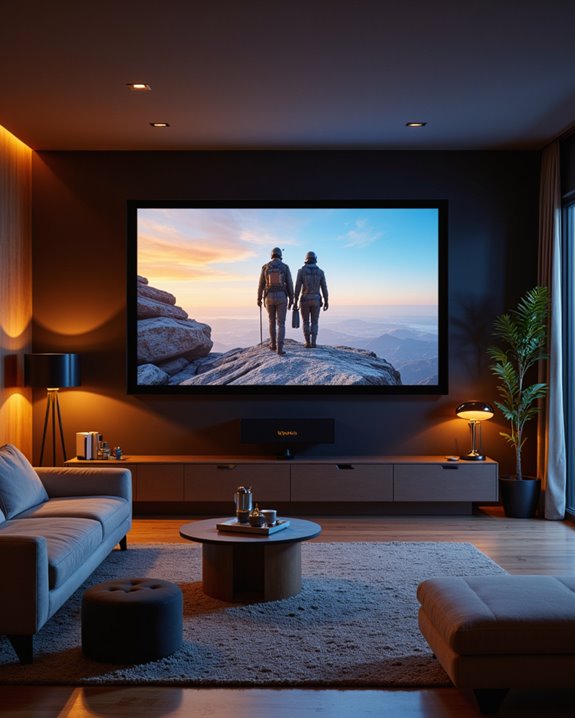
Recent innovations in screen paint technology have transformed the home theater experience by delivering professional-grade projection surfaces at a fraction of traditional costs. Modern formulations now offer superior color accuracy and environmental durability, with enhanced pigments that maintain image quality over time.
The latest advancements include improved ambient light rejection properties, allowing screens to perform well in various lighting conditions. These new paints support ultra-high-definition resolutions up to 4K, with some formulations ready for future 8K compatibility. Like the Dolby Vision features in XGIMI’s latest projectors, these paints are optimized for HDR content delivery. Manufacturers have also developed eco-friendly options that require minimal maintenance while providing excellent image clarity.
Smart technology integration is becoming more common, with paint surfaces designed to work seamlessly with AI-enabled projectors and automated home theater systems. This advancement ensures ideal performance without requiring complex installation procedures or special equipment.
Frequently Asked Questions
How Long Does Projector Screen Paint Typically Last Before Needing Reapplication?
High-quality projector screen paint demonstrates exceptional durability, typically lasting a lifetime under normal conditions. Reapplication frequency is virtually indefinite, with manufacturers offering lifetime warranties. Only surface damage might necessitate spot touch-ups.
Can Projector Screen Paint Be Applied Over Existing Wall Textures?
While projector screen paint can be applied over minimal textures, proper wall preparation is essential. Paint compatibility depends on surface smoothness – significant textures require sanding or skim coating for ideal performance and image quality.
Does Projector Paint Affect Regular Room Lighting When Not in Use?
Projector paint’s impact on ambient lighting is remarkably minimal when not projecting. While darker wall colors may slightly reduce room reflectivity, the specialized paint maintains normal lighting conditions similar to standard wall paint.
Can Multiple Coats of Projector Paint Improve Image Quality Significantly?
Multiple coats of projector paint considerably enhance image quality through improved coating thickness and color consistency. The layered application creates a smoother surface, reducing irregularities and hotspots while ensuring uniform light reflection across the screen.
Is It Possible to Remove Projector Paint Completely if Needed Later?
Projector paint removal is challenging but possible through careful wall preparation, sanding, and chemical stripping. Complete removal often requires professional expertise, as the specialized coating bonds strongly to surfaces and may leave residual effects.


